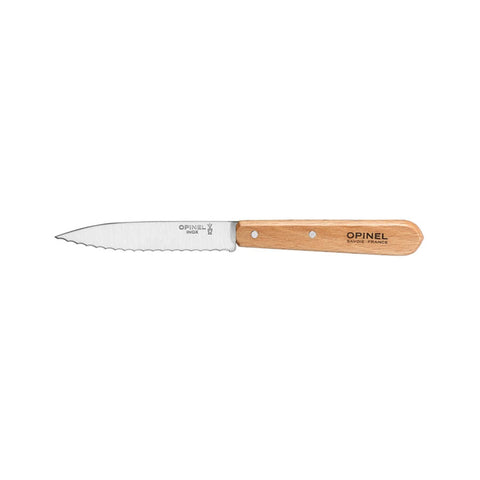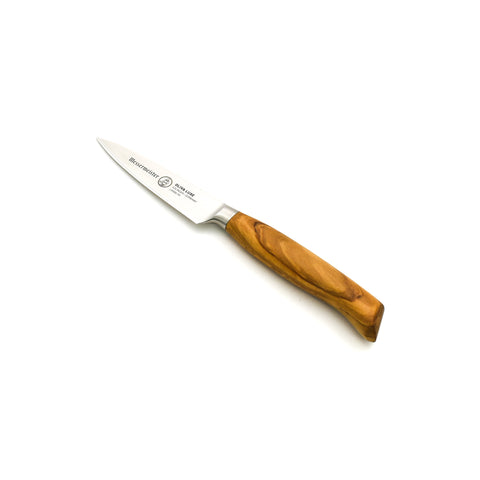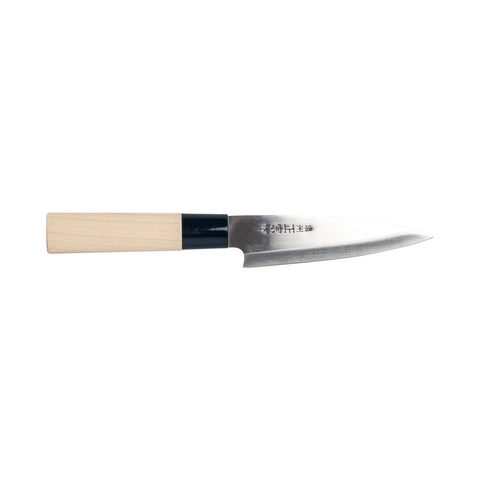The Art of Peeling with a Knife: A Practical Guide for Everyone

Peeling with a knife is a skill that combines precision, technique, and a bit of practice, making it an essential tool in any kitchen.
Whether you’re preparing a simple meal or tackling a gourmet recipe, knowing how to peel with a knife can save time and enhance the quality of your dishes.
In this guide, we will walk through the art of peeling with a knife, offering practical tips and step-by-step instructions suitable for beginners and seasoned cooks alike.
Choosing a knife with the appropriate blade length, typically ranging from 7 to 11 cm, is crucial for precise peeling tasks.
Can You Peel With A Knife?
Why Choose a Knife Over a Peeler
There are several reasons to choose a knife over a peeler for your kitchen tasks.
Firstly, peeling with a knife offers greater versatility. You can use the same knife for slicing, dicing, and other prep work, reducing the number of tools you need.
Additionally, when you peel potatoes, you can compare the pros and cons of using a knife versus a peeler to decide which method is best for you.
Secondly, a knife allows for more control, especially when dealing with irregularly shaped or delicate produce.
While peelers are great for uniform results, a knife can navigate curves and bumps with ease. Additionally, knives tend to be more durable and don’t require replacements as often as peelers.
With a good-quality knife, you can achieve precise cuts and maintain sharpness over time.
Finally, mastering knife skills can improve your overall cooking efficiency and make you a more competent cook.
By learning the process of peeling potatoes with a knife, including using a sharp paring knife to remove the skin, washing the potato thoroughly, and cutting off any bruised or blemished areas, you add a valuable skill to your culinary repertoire.
Common Types of Knives for Peeling
When it comes to peeling with a knife, selecting the right type of knife is crucial. Peeling knives, usually with a blade length of approximately 7 to 11 cm, are designed for fine and precise cutting tasks, such as peeling fruit and vegetables.
The most common knife used for peeling is the sharp paring knife. Its small size and sharp point make it ideal for intricate tasks and detailed work, such as peeling the skin off a potato.
Another good option is the utility knife, which is slightly larger than a paring knife and provides a bit more versatility for various kitchen tasks.
For those looking for something more specialised, a peeling knife, often referred to as a “tourné” knife, features a curved blade that allows for easy peeling of round fruits and vegetables.
Lastly, some cooks prefer using a chef’s knife for peeling larger items, although this requires a higher skill level.
Each type of knife has its advantages, and the best choice depends on the task at hand and your personal comfort with the tool.
Below are the top peeling knife suggestion we have for you:
The Opinel Essentials beech handle serrated knife is perfect for slicing tomatoes without squashing them. It’s a must-have for salads and sandwiches. The micro-serrations glide through fruits, vegetables, boiled eggs, and cakes effortlessly.
The blade, made from high-carbon Sandvik stainless steel, ensures excellent cutting quality and resists corrosion. The durable handle is crafted from French beechwood.
The Messermeister Oliva paring knife is perfect for detailed kitchen tasks. Made in Solingen, Germany, it features high-quality stainless steel. Ideal for peeling delicate fruit, finely slicing garlic, or trimming vegetables.
The Japanese petty knife is perfect for delicate tasks like peeling fruits, removing potato eyes, and intricate carving. It's small enough for hand use yet comfortable on a chopping board.
Basic Knife Peeling Techniques
Holding the Knife Correctly
Properly holding your knife is the foundation of effective and safe peeling. Start by gripping the knife handle firmly with your dominant hand. Your thumb and index finger should pinch the blade just above the handle, creating a secure and controlled grip.
This technique, known as the "pinch grip," offers better manoeuvrability and precision. Your remaining fingers should wrap around the handle for added stability.
It's essential to keep your wrist flexible but steady, allowing for smooth, controlled movements. Meanwhile, your non-dominant hand will hold the item you're peeling. Position your fingers in a claw-like shape to keep them safe from the blade.
This grip ensures that your knuckles guide the knife, reducing the risk of accidental cuts. By mastering this grip, you set the stage for efficient and safe peeling with a knife.
Peeling Different Vegetables
Peeling different vegetables requires adapting your technique to suit each type. For root vegetables like carrots and potatoes, start by cutting off both ends to create a stable base. When peeling potatoes, use a sharp paring knife to remove the skin, wash the potato thoroughly, and cut off any bruised or blemished areas.
This allows you to peel downwards in long, even strokes. With round vegetables such as tomatoes or beetroots, it helps to blanch them briefly in boiling water and then plunge them into ice water. This makes the skin easier to remove with a knife.
For leafy vegetables like cabbage, you’ll want to slice the outer leaves off first before peeling the inner layers. With more delicate vegetables like asparagus or broccoli stems, use a light touch and shallow cuts to avoid wasting the tender parts.
Each vegetable presents its own challenges, but with practice, you will develop an instinct for how to handle each one efficiently. Adapting your method ensures you maintain the integrity and appearance of the vegetables.
Peeling Fruits Safely
Peeling fruits safely requires extra attention due to their often softer and slipperier surfaces. Start by securing the fruit on a stable surface, such as a cutting board. For round fruits like apples and pears, cutting off the top and bottom can create a flat base, making it easier to peel.
Use a gentle sawing motion to remove the skin, working from top to bottom. For citrus fruits, scoring the peel lightly before peeling can help make the process smoother. With smaller fruits like kiwis or mangoes, a spoon can be used to scoop out the flesh after cutting the fruit in half.
Always keep your fingers tucked away from the blade and maintain a steady hand to avoid slips. By taking these precautions, you can peel fruits efficiently while minimising the risk of cuts and maintaining the integrity of the fruit.
Advanced Knife Peeling Skills
Decorative Peeling Methods
Decorative peeling methods can transform ordinary fruits and vegetables into visually appealing garnishes and dishes. One popular technique is creating vegetable ribbons. Using a sharp knife, slice thin, even strips from vegetables like cucumbers, carrots, or courgettes.
These ribbons can add a decorative touch to salads or appetisers. Another method is carving garnishes from fruits such as apples or oranges. You can carve intricate patterns into the skin or create shapes like flowers and leaves.
For citrus fruits, zesting with a knife can produce long, elegant strips of peel that add both flavour and visual interest to dishes. Spiral cuts are also a fun way to present fruits and vegetables.
Carefully cut a continuous, spiral strip of peel from fruits like apples or potatoes. Mastering these decorative techniques can elevate the presentation of your dishes, making them as pleasing to the eye as they are to the palate.
Speed Peeling Techniques
Speed peeling techniques are invaluable for saving time in the kitchen, especially when preparing large quantities. To start, ensure your knife is sharp, as a dull blade will slow you down and increase the risk of injury.
A paring knife is often the best choice for speed peeling due to its small size and manoeuvrability. Position the vegetable or fruit securely on a cutting board, using the non-dominant hand to stabilise it. With a firm grip on the knife, use swift, downward strokes to remove the peel in long, continuous strips.
Practice makes perfect, so start slowly and gradually increase your speed as you become more confident. Another technique is to rotate the produce while peeling, allowing you to maintain a steady rhythm.
By refining your speed peeling skills, you can significantly cut down on prep time, making your cooking process more efficient without sacrificing quality or safety.
Common Mistakes and How to Avoid Them
Safety Tips for Beginners
For beginners, safety is paramount when peeling with a knife. Start by ensuring your knife is sharp; a dull blade requires more force and increases the risk of slipping. Always use a stable cutting board to prevent the fruit or vegetable from moving.
Your non-dominant hand should adopt a claw-like grip, tucking fingers under to keep them safe from the blade. Never rush the process; take your time to build confidence and precision.
It's also crucial to keep your knife clean and dry to maintain a firm grip. Avoid talking or becoming distracted while peeling; focus on the task at hand. If you need to adjust the item you're peeling, set the knife down first to avoid accidents.
By following these safety tips, you can minimise the risk of injury and create a safer, more efficient kitchen environment as you develop your peeling skills.
Handling Difficult Skins
Handling difficult skins requires specific techniques to avoid frustration and potential injury. For tough-skinned vegetables like butternut squash or pumpkins, begin by cutting them into manageable sections. Use a sharp, sturdy knife and make sure to stabilise the vegetable on a secure surface.
For fruits with thick skins, such as pineapples or melons, slice off the top and bottom to create a flat base, then carefully cut away the skin in downward strokes. For produce like tomatoes or peaches, blanching them in boiling water for a few seconds and then transferring them to an ice bath can loosen the skin, making it easier to peel.
Always take your time and use controlled, steady movements. For particularly stubborn skins, it may be helpful to use a sawing motion. By employing these techniques, you can handle even the most difficult skins with confidence and ease, ensuring a smooth and safe peeling process.
Maintaining Your Peeling Knife
Sharpening Your Knife
Keeping your knife sharp is essential for effective and safe peeling. A sharp knife requires less force, reducing the likelihood of slips and accidents. To sharpen your knife, you can use a whetstone, a honing rod, or an electric sharpener.
If using a whetstone, start by soaking it in water for about 10 minutes. Hold the knife at a 20-degree angle to the stone and glide the blade across it, alternating sides to ensure an even edge. For a honing rod, hold it vertically and draw the knife down the rod in a sweeping motion, again alternating sides.
Electric sharpeners simplify the process but ensure you follow the manufacturer's instructions. Regular maintenance, such as honing your knife before each use and sharpening it periodically, will keep the blade in optimal condition.
A sharp knife not only improves efficiency but also enhances the overall peeling experience.
Proper Knife Storage
Proper knife storage is essential for maintaining the longevity and sharpness of your peeling knife. Storing knives loosely in a drawer can lead to dull blades and potential accidents. Instead, consider using a knife block, magnetic strip, or blade guards.
A knife block keeps your knives organised and protected, while a magnetic strip allows easy access and saves counter space. Blade guards are particularly useful if you need to store knives in a drawer, protecting the blade and your fingers.
Ensure knives are clean and dry before storing to prevent rust and bacteria growth. Avoid stacking knives, as this can cause nicks and dull edges. If you travel with your knife, use a knife case to keep it secure.
Proper storage not only extends the life of your knife but also ensures a safer kitchen environment. By adopting these storage practices, you can keep your peeling knife in peak condition.





